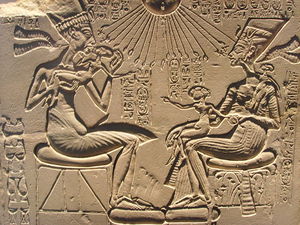
|
| ©Gerbil |
| The unusual features of Pharaoh Akhenaten, who founded the city commonly known today as Amarna, are seen here in this family group |
Amarna, Egypt's capital for a brief period, may have had a deprived population under nearly unbearable conditions during the reign of Akhenaten, the ruler between 1379 and 1362 BC. Amarna is the only ancient city in Egypt for which there are great details of its internal plan, but due to its unique creation and desertion its accuracy in regard to representation of Egypt is questionable. The city was abandoned no more than 10 years after Akhenaten's death.
Regardless of its similarities to other cities in Egypt, it is surprisingly opposite of the way it has often been represented. Studies of remains of ancient Egyptians in an Amarnan cemetery conducted by Barry Kemp and Gerome Rose reveal a great deal about the cities' population. Those who lived in Amarna worked under severe conditions and were often sick and deprived. Studies of the bones show that many citizens of Amarna suffered from fractured bones, stunted growth and anemia, and that mortality rates in children were surprisingly high.
Cemeteries in Egypt have been largely excavated in the past for objects, and little to no attention has been paid to the remains of the people buried there, according to Kemp. And Rose, an anthropology professor at the University of Arkansas thinks some of the adults buried in Amarna might have been brought there from various other parts of Egypt. He said, "This means that we have a period of deprivation in Egypt prior to the Amarna phase." This leads researchers to believe that perhaps Akhenaten claimed to try to change things to provide better conditions for Egyptians.
The whole concept of studying the human remains of a place to gather ideas about the population's health is a new one. The paintings and articles in tombs of the time suggest something which completely conflicts with the remains of the ordinary people.
Some of the remains discovered and treated indicated injuries to the spine among teens due most likely to accidents which occurred when constructing the city. According to Rose 44 percent of adults had anemia, as well as 74 percent of children and teens. Men only stood around 5'2" tall; women were even shorter, most likely due to a lack of protein in the diet. According to Rose, people were not growing to their full potential. He said, "Adult heights are used as a proxy for overall standard of living...we are seeing a more realistic picture of what life was like."
The team plans on further excavations to solidify this new knowledge.



Reader Comments